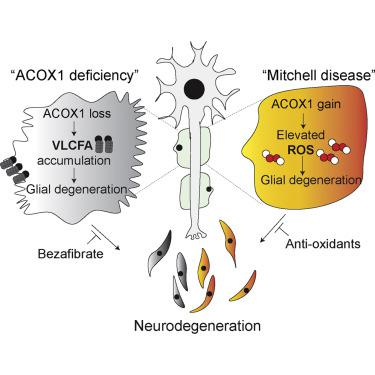Our official English website, www.x-mol.net, welcomes your
feedback! (Note: you will need to create a separate account there.)
Loss- or Gain-of-Function Mutations in ACOX1 Cause Axonal Loss via Different Mechanisms.
Neuron ( IF 14.7 ) Pub Date : 2020-03-12 , DOI: 10.1016/j.neuron.2020.02.021
Hyung-Lok Chung 1 , Michael F Wangler 2 , Paul C Marcogliese 3 , Juyeon Jo 4 , Thomas A Ravenscroft 3 , Zhongyuan Zuo 3 , Lita Duraine 5 , Sina Sadeghzadeh 6 , David Li-Kroeger 3 , Robert E Schmidt 7 , Alan Pestronk 7 , Jill A Rosenfeld 8 , Lindsay Burrage 8 , Mitchell J Herndon 7 , Shan Chen 8 , , Amelle Shillington 9 , Marissa Vawter-Lee 10 , Robert Hopkin 9 , Jackeline Rodriguez-Smith 11 , Michael Henrickson 11 , Brendan Lee 8 , Ann B Moser 12 , Richard O Jones 12 , Paul Watkins 12 , Taekyeong Yoo 13 , Soe Mar 14 , Murim Choi 15 , Robert C Bucelli 16 , Shinya Yamamoto 17 , Hyun Kyoung Lee 18 , Carlos E Prada 9 , Jong-Hee Chae 19 , Tiphanie P Vogel 20 , Hugo J Bellen 21
Neuron ( IF 14.7 ) Pub Date : 2020-03-12 , DOI: 10.1016/j.neuron.2020.02.021
Hyung-Lok Chung 1 , Michael F Wangler 2 , Paul C Marcogliese 3 , Juyeon Jo 4 , Thomas A Ravenscroft 3 , Zhongyuan Zuo 3 , Lita Duraine 5 , Sina Sadeghzadeh 6 , David Li-Kroeger 3 , Robert E Schmidt 7 , Alan Pestronk 7 , Jill A Rosenfeld 8 , Lindsay Burrage 8 , Mitchell J Herndon 7 , Shan Chen 8 , , Amelle Shillington 9 , Marissa Vawter-Lee 10 , Robert Hopkin 9 , Jackeline Rodriguez-Smith 11 , Michael Henrickson 11 , Brendan Lee 8 , Ann B Moser 12 , Richard O Jones 12 , Paul Watkins 12 , Taekyeong Yoo 13 , Soe Mar 14 , Murim Choi 15 , Robert C Bucelli 16 , Shinya Yamamoto 17 , Hyun Kyoung Lee 18 , Carlos E Prada 9 , Jong-Hee Chae 19 , Tiphanie P Vogel 20 , Hugo J Bellen 21
Affiliation

|
ACOX1 (acyl-CoA oxidase 1) encodes the first and rate-limiting enzyme of the very-long-chain fatty acid (VLCFA) β-oxidation pathway in peroxisomes and leads to H2O2 production. Unexpectedly, Drosophila (d) ACOX1 is mostly expressed and required in glia, and loss of ACOX1 leads to developmental delay, pupal death, reduced lifespan, impaired synaptic transmission, and glial and axonal loss. Patients who carry a previously unidentified, de novo, dominant variant in ACOX1 (p.N237S) also exhibit glial loss. However, this mutation causes increased levels of ACOX1 protein and function resulting in elevated levels of reactive oxygen species in glia in flies and murine Schwann cells. ACOX1 (p.N237S) patients exhibit a severe loss of Schwann cells and neurons. However, treatment of flies and primary Schwann cells with an antioxidant suppressed the p.N237S-induced neurodegeneration. In summary, both loss and gain of ACOX1 lead to glial and neuronal loss, but different mechanisms are at play and require different treatments.
中文翻译:

ACOX1 中功能丧失或获得的突变通过不同机制导致轴突损失。
ACOX1(酰基辅酶A氧化酶1)编码过氧化物酶体中极长链脂肪酸(VLCFA)β-氧化途径的第一个限速酶,并导致H2O2的产生。出乎意料的是,果蝇 (d) ACOX1 主要在神经胶质细胞中表达和需要,ACOX1 的缺失会导致发育迟缓、蛹死亡、寿命缩短、突触传递受损以及神经胶质细胞和轴突损失。携带先前未识别的 ACOX1 新显性变异 (p.N237S) 的患者也表现出神经胶质细胞丢失。然而,这种突变会导致 ACOX1 蛋白和功能水平升高,从而导致果蝇和鼠雪旺细胞的神经胶质细胞中活性氧水平升高。 ACOX1 (p.N237S) 患者表现出雪旺细胞和神经元的严重损失。然而,用抗氧化剂处理果蝇和原代雪旺细胞可抑制 p.N237S 诱导的神经变性。总之,ACOX1 的丢失和增加都会导致神经胶质和神经元损失,但发挥作用的机制不同,需要不同的治疗。
更新日期:2020-03-12
中文翻译:

ACOX1 中功能丧失或获得的突变通过不同机制导致轴突损失。
ACOX1(酰基辅酶A氧化酶1)编码过氧化物酶体中极长链脂肪酸(VLCFA)β-氧化途径的第一个限速酶,并导致H2O2的产生。出乎意料的是,果蝇 (d) ACOX1 主要在神经胶质细胞中表达和需要,ACOX1 的缺失会导致发育迟缓、蛹死亡、寿命缩短、突触传递受损以及神经胶质细胞和轴突损失。携带先前未识别的 ACOX1 新显性变异 (p.N237S) 的患者也表现出神经胶质细胞丢失。然而,这种突变会导致 ACOX1 蛋白和功能水平升高,从而导致果蝇和鼠雪旺细胞的神经胶质细胞中活性氧水平升高。 ACOX1 (p.N237S) 患者表现出雪旺细胞和神经元的严重损失。然而,用抗氧化剂处理果蝇和原代雪旺细胞可抑制 p.N237S 诱导的神经变性。总之,ACOX1 的丢失和增加都会导致神经胶质和神经元损失,但发挥作用的机制不同,需要不同的治疗。

































 京公网安备 11010802027423号
京公网安备 11010802027423号